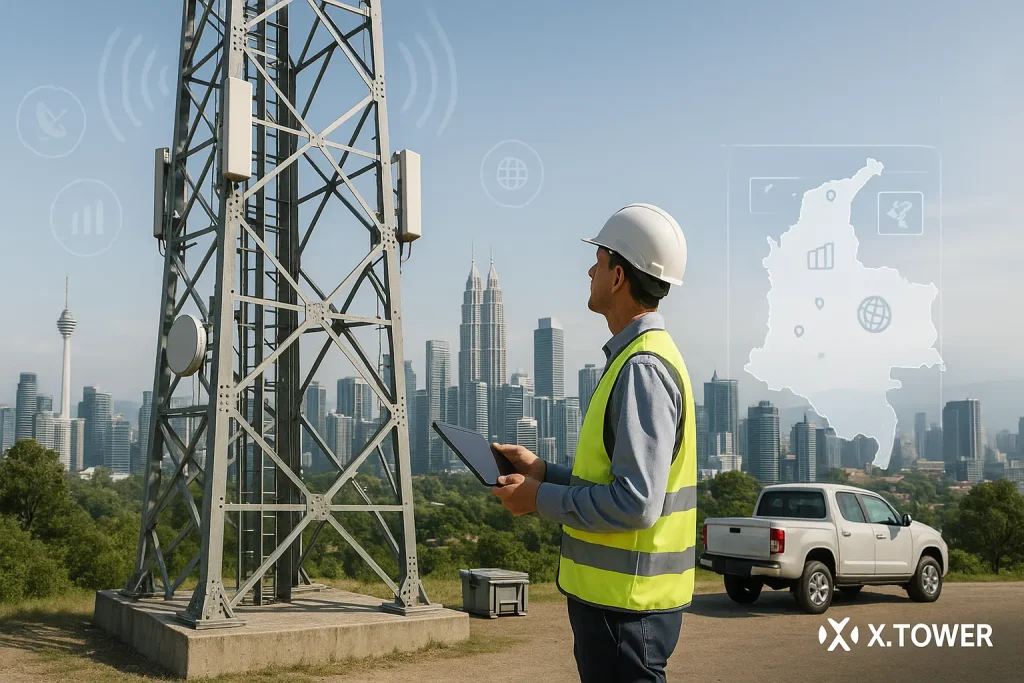Malaysia’s Communication Tower Industry
2025-09-25
A communication tower in Malaysia is fundamental to the nation's digital aspirations. Malaysia is a rapidly developing country. It has a high rate of digital adoption. This creates a constant and growing demand for robust telecommunications infrastructure. The country's unique blend of modern urban centers and dense rainforests presents distinct challenges. Mobile network operators and infrastructure providers need expert partners. These partners must deliver resilient towers and innovative deployment solutions. A leading supplier understands Malaysia’s diverse geographical and regulatory landscape. They build the essential foundation for expanding 4G and advancing 5G networks nationwide.

Key Drivers Shaping the Malaysian Tower Market
The demand for a communication tower in Malaysia is propelled by several strong market forces. The government's strategic vision, competitive mobile operators, and an increasingly digital population all contribute. These factors drive continuous investment in the country's telecom infrastructure. Understanding these key drivers is crucial. It helps to grasp the current state and future direction of the Malaysian tower industry. They underpin the ongoing need for new sites and technological upgrades.
The National 5G Rollout Initiative
Malaysia is aggressively pursuing a nationwide 5G rollout. This initiative is a primary driver for the communication tower in Malaysia market. The government has opted for a single wholesale network model. This aims to accelerate deployment and ensure equitable access. 5G technology requires a denser network of base stations. It also necessitates upgrades to existing towers. These upgrades support new, heavier, and more complex antennas. This rapid transition to 5G is fueling significant investment in new infrastructure. It demands a highly responsive and capable supply chain.
Bridging the Urban-Rural Digital Divide
Despite significant progress, a digital divide still exists between urban and rural areas. The government is committed to providing universal access to high-speed internet. Programs aim to extend coverage to underserved communities. This includes remote villages in Borneo and less populated mainland regions. Building a communication tower in Malaysia's rural areas is central to this strategy. These projects deliver essential connectivity. They enable access to education, healthcare, and economic opportunities for all citizens.
Robust Growth of the Digital Economy
Malaysia has a thriving digital economy. E-commerce, fintech, and digital content consumption are booming. This growth heavily relies on pervasive and reliable mobile connectivity. A robust communication tower in Malaysia enables these digital services. It empowers businesses and consumers across the country. The continuous expansion of this digital ecosystem creates a sustained demand for network capacity. This requires ongoing investment in both new tower sites and capacity upgrades for existing ones.
High Mobile Penetration and Data Consumption
Malaysia boasts very high mobile phone penetration rates. Its population is also a heavy consumer of mobile data. Streaming media, social networking, and online gaming are extremely popular activities. This intense data usage places continuous pressure on network infrastructure. Mobile network operators must constantly expand and densify their networks. They need to build more towers and upgrade existing ones. This sustained consumer demand is a fundamental market driver for every communication tower in Malaysia.
Operational Challenges in the Malaysian Tower Sector
Deploying a communication tower in Malaysia involves navigating distinct operational challenges. The country's varied geography, from coastlines to dense jungles, creates a complex environment. A successful infrastructure provider must possess specialized expertise. These challenges impact every phase of a project. They range from logistical planning to site acquisition and long-term maintenance. Effectively addressing these hurdles is a key differentiator for leading tower companies.
Engineering for Tropical Climates
Malaysia experiences a tropical rainforest climate. This means high temperatures, high humidity, and heavy rainfall year-round. These conditions accelerate corrosion of steel structures. A communication tower in Malaysia must be designed with superior anti-corrosion protection. This typically involves high-quality hot-dip galvanization. It may also include specialized coatings. Engineers must also consider heavy wind loads from monsoons and tropical storms. Durability in this harsh environment is paramount.
Navigating Diverse Terrain and Logistics
The terrain in Malaysia is highly varied. It includes coastal plains, mountainous interiors, and dense rainforests, particularly in East Malaysia (Borneo). Transporting heavy tower components to remote inland sites or across islands presents significant logistical challenges. Road access can be limited. A top provider of a communication tower in Malaysia must have a robust logistics network. They need experience in planning and executing complex supply chain operations across diverse geographical conditions. This mirrors the complex logistical demands seen by a communication tower Indonesia.
Regulatory Compliance and Permitting Processes
The telecommunications sector in Malaysia is regulated by the Malaysian Communications and Multimedia Commission (MCMC). Beyond national regulations, local authorities also have a say in site permits and zoning. Navigating these multi-layered processes can be complex and time-consuming. An experienced provider of a communication tower in Malaysia has a dedicated team. This team manages regulatory compliance and secures necessary permits efficiently. This expertise helps prevent delays and ensures project adherence to all legal frameworks.
Community Engagement and Aesthetic Concerns
Site acquisition, especially in urban or residential areas, requires careful community engagement. Concerns about visual impact and health perceptions can lead to opposition. A responsible provider works closely with local communities. They address concerns transparently. They also offer aesthetically pleasing tower designs where appropriate. Concealed monopoles or rooftop installations are common in urban settings. This approach fosters acceptance and smoother project execution.
The Structure of Malaysia's Communication Tower Market
The market for a communication tower in Malaysia is well-developed and competitive. It is characterized by the presence of large independent tower companies. These towercos play a central role in the country's telecom infrastructure. They work alongside mobile network operators and a network of suppliers. Understanding this market structure is essential for any participant in the sector. It defines the relationships and business dynamics that drive industry growth and efficiency.
The Strong Presence of Independent Towercos
Independent tower companies are significant players in Malaysia. They own and operate substantial portfolios of communication towers. These towercos lease space on their towers to multiple mobile network operators. This tower-sharing model is highly efficient. It allows operators to expand their networks with reduced capital expenditure. These towercos are the primary clients for companies that manufacture, install, and maintain a communication tower in Malaysia. Their investment strategies are a key driver of market activity. This structure is common in the broader market for telecom towers Asia-Pacific.
A Dynamic Mobile Network Operator Landscape
Malaysia has a competitive mobile network operator (MNO) market. Major players like Maxis, CelcomDigi, and U Mobile compete intensely for subscribers. Their continuous efforts to improve network coverage and capacity drive the demand for new tower sites. These MNOs' network expansion plans determine where and when new infrastructure is required. A company involved with a communication tower in Malaysia must be responsive to the evolving needs of these key operators. The full list of mobile network operators shapes the primary client base.
Ecosystem of International Suppliers and Local Partners
The Malaysian tower industry is supported by an ecosystem of global and local companies. International manufacturers supply advanced steel towers, antennas, and related equipment. They bring global quality standards and cutting-edge technology. These international firms often collaborate with local engineering and construction partners. These local companies provide vital on-the-ground expertise, labor, and local regulatory knowledge. Successful projects require seamless coordination between all these stakeholders. This collaborative model is also seen in the market for a telecommunications tower Vietnam.
Focus on Passive Infrastructure Sharing
Malaysia's telecom industry places a strong emphasis on infrastructure sharing. This reduces duplication of assets and promotes efficiency. Beyond physical towers, there are initiatives to share fiber optic networks and other passive infrastructure. This focus ensures that capital is deployed effectively. A provider of a communication tower in Malaysia often designs structures that facilitate multi-tenancy. This supports the industry's drive for shared infrastructure.
Technological Innovations and Future Outlook
The technology associated with a communication tower in Malaysia is continually advancing. Innovation is driven by the nationwide 5G rollout, the need for sustainability, and evolving urban demands. A leading provider must be at the forefront of these technological trends. They need to offer solutions that are resilient, efficient, and ready for the future of mobile communications. These advancements are shaping the next generation of Malaysia's digital infrastructure.
5G-Ready Infrastructure and Densification
The ongoing 5G rollout is the biggest technological catalyst. 5G antennas, particularly Massive MIMO arrays, are heavier and more complex. A communication tower in Malaysia must be capable of supporting these increased loads. This requires sophisticated structural engineering for both new builds and upgrades. 5G also demands a denser network. This leads to increased deployment of small cells and urban monopoles. This densification is a key growth area for tower suppliers.
The Push Towards Green Energy Solutions
Sustainability is a growing priority in Malaysia. There is increasing pressure to reduce the carbon footprint of telecom infrastructure. This is especially true for remote, off-grid sites. A leading provider of a communication tower in Malaysia offers integrated green energy solutions. These hybrid power systems typically combine solar panels and battery storage with an efficient backup generator. These solutions reduce operating costs and environmental impact, aligning with national sustainability goals.
Diverse Tower Types for Varied Environments
Malaysia's diverse geography requires a range of tower designs. A single type of tower cannot meet all needs. A comprehensive provider offers a portfolio of different structures for a communication tower in Malaysia. This includes:
- Self-Supporting Lattice Towers: Robust structures for heavy loads and rural coverage.
- Guyed Masts: Cost-effective solutions for achieving height in flatter, less densely populated areas.
- Monopoles: Sleek and aesthetically pleasing for urban and suburban environments.
- Rooftop Installations: Discreet solutions for building tops in dense city centers.
- Concealed Structures: Designs that blend into the environment, such as disguised flagpoles or "tree" towers.
Advanced Remote Monitoring and Analytics
Managing a large portfolio of towers across diverse terrain is complex. Remote monitoring technology is becoming indispensable. These systems allow towercos to track the performance of each communication tower in Malaysia from a central operations center. They monitor power systems, fuel levels, equipment health, and security. This technology improves operational efficiency, reduces maintenance costs, and enables faster response times to issues. This advanced management is also a critical aspect for a cell tower supplier Philippines.
Conclusion
Malaysia’s communication tower industry is a vibrant and essential sector. It is driven by the nation's ambitious 5G rollout, a growing digital economy, and the need to connect all citizens. The market presents unique challenges related to its tropical climate and diverse geography. It is characterized by a strong towerco model and a competitive MNO landscape. The future of a communication tower in Malaysia will be shaped by continued 5G densification, a strong focus on sustainable power, and innovative design solutions. Leading providers are crucial partners in building the robust, resilient, and intelligent infrastructure required for Malaysia's digital future. The strategic imperative of a cell tower leasing Indonesia is mirrored by the towerco models driving growth in Malaysia.

Hey, I’m Chunjian Shu
"X.Y. Tower: Reliable, innovative solutions for high-quality towers and electrical equipment with professional service.
